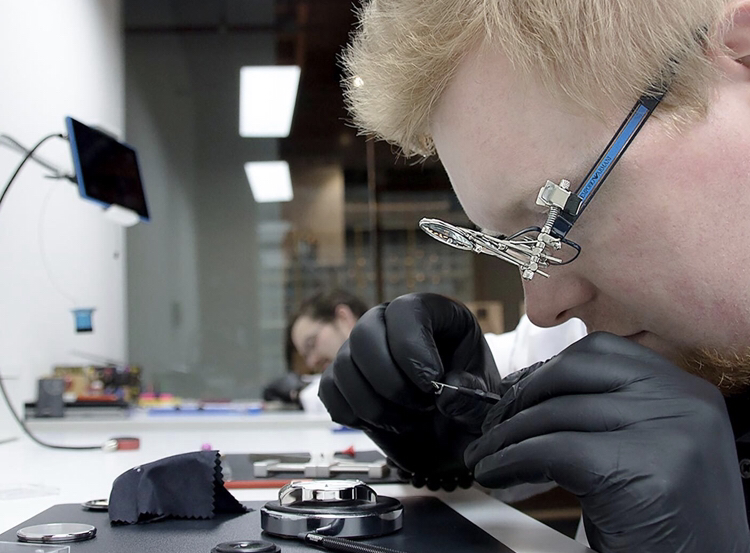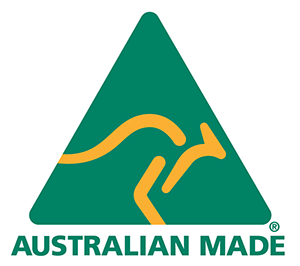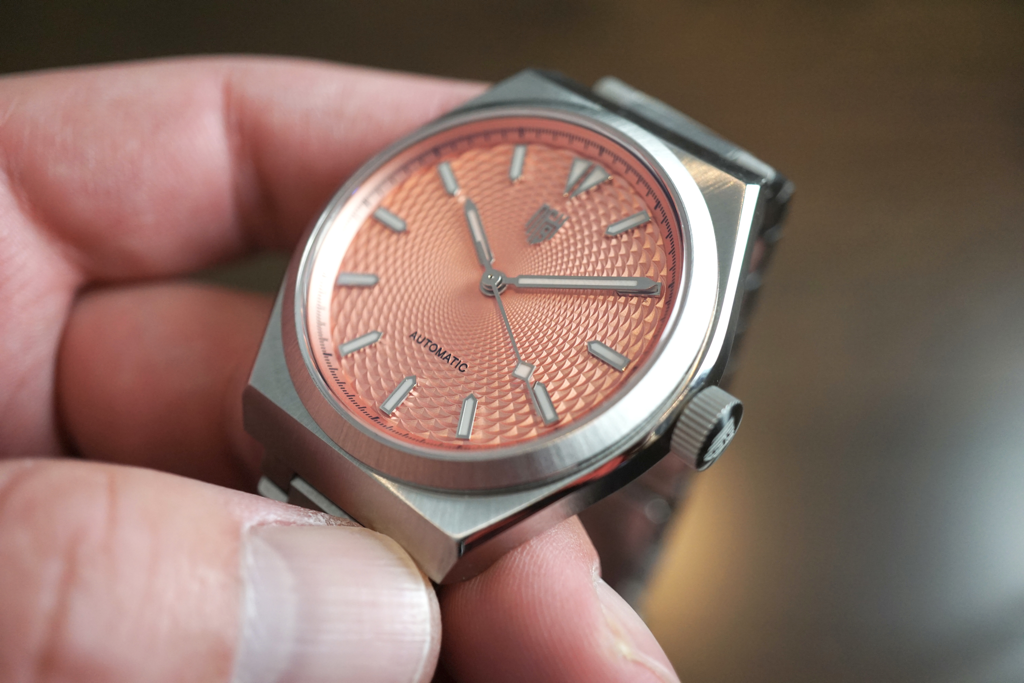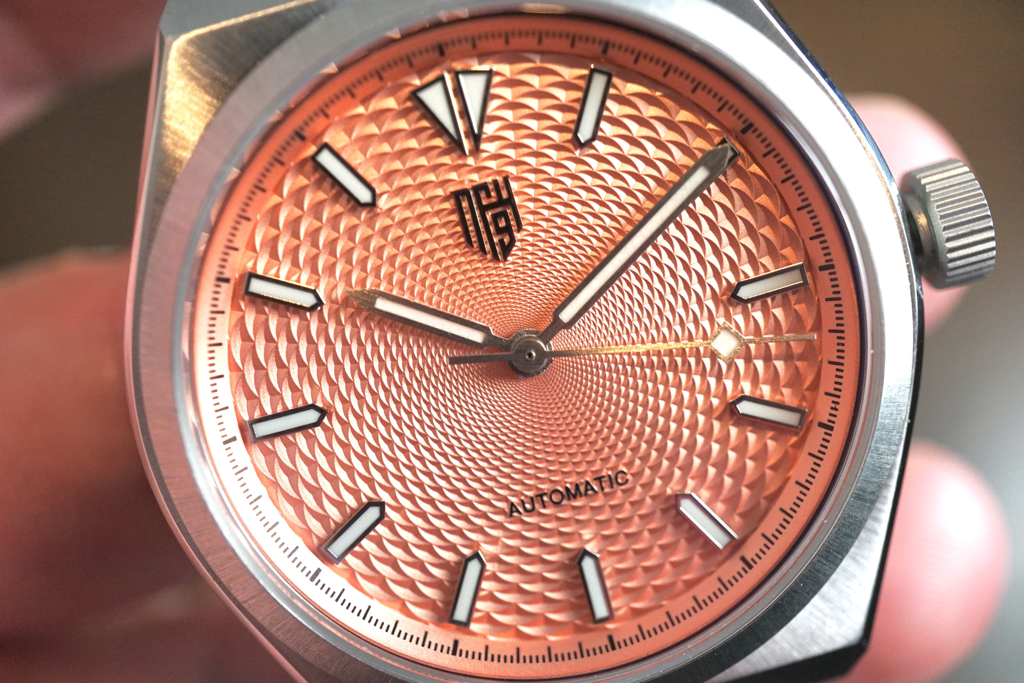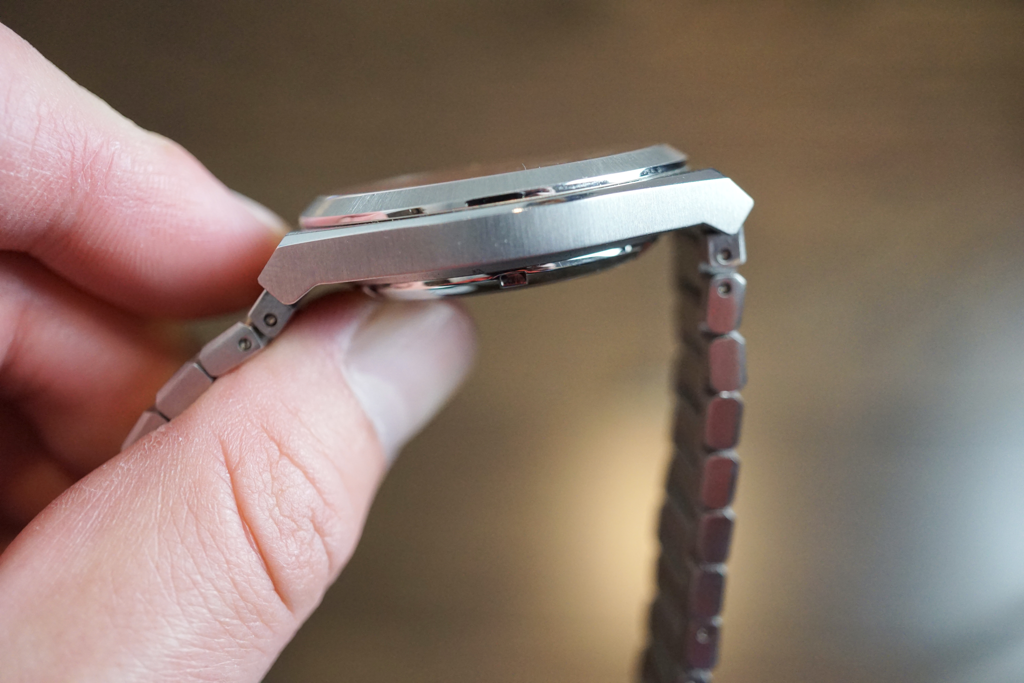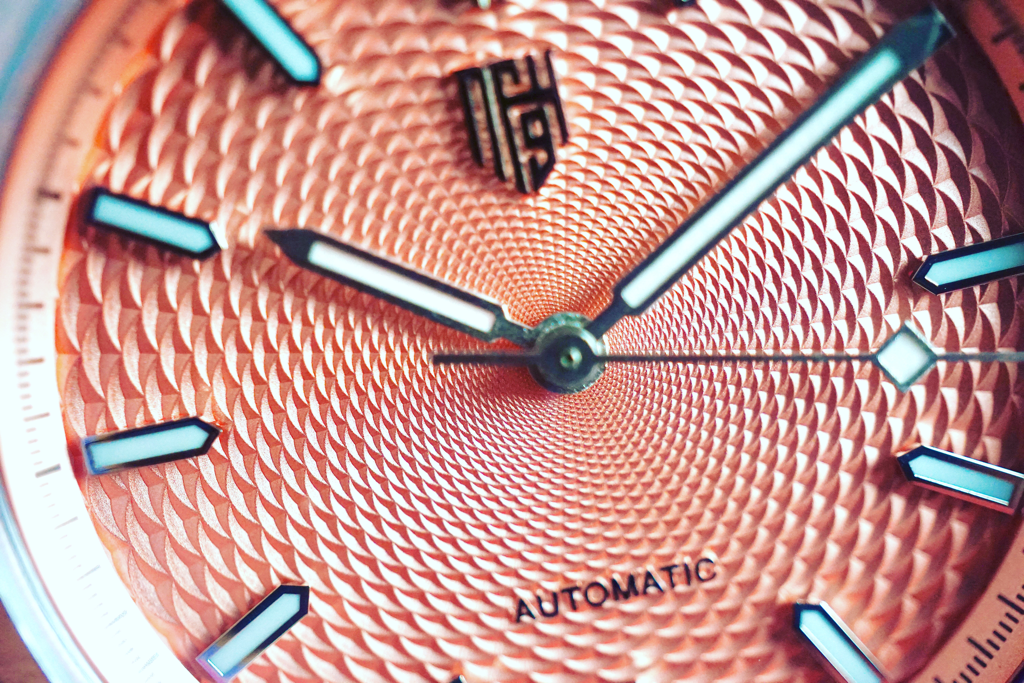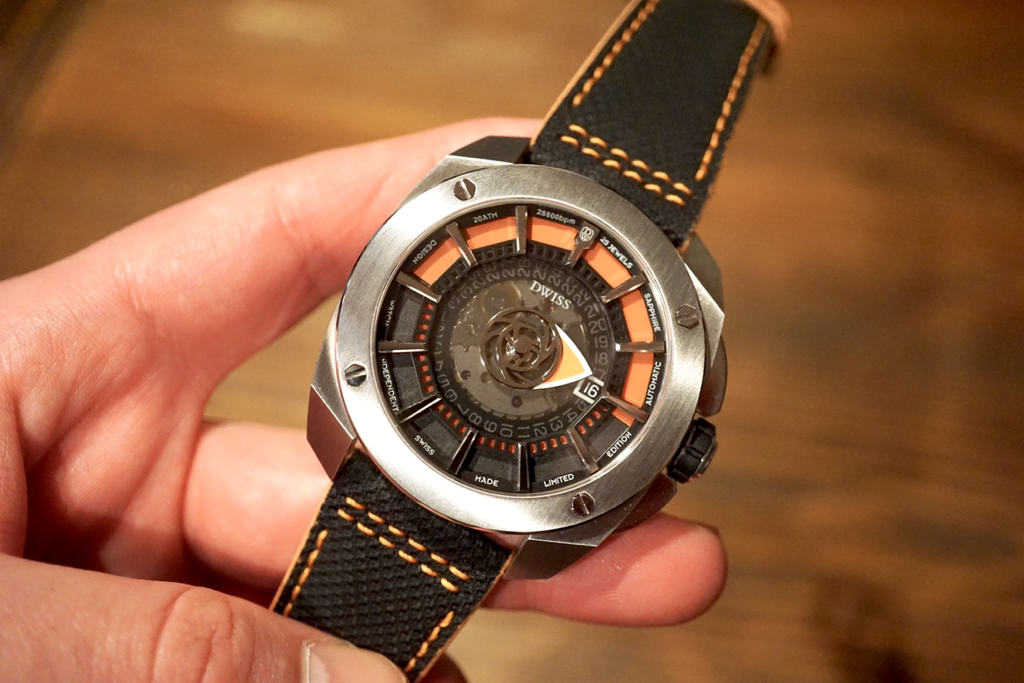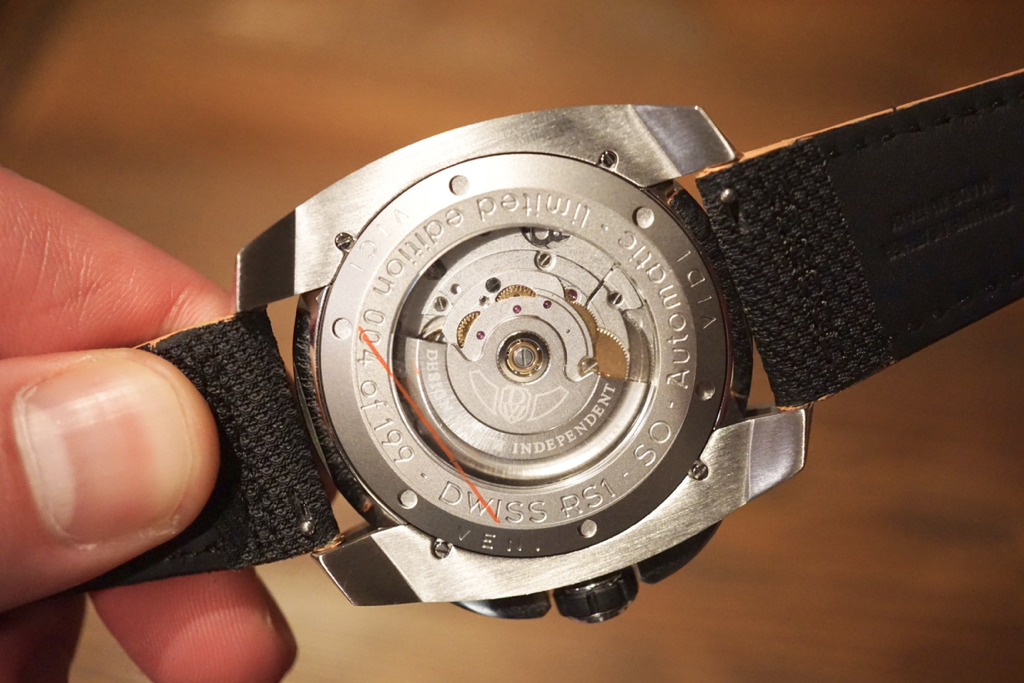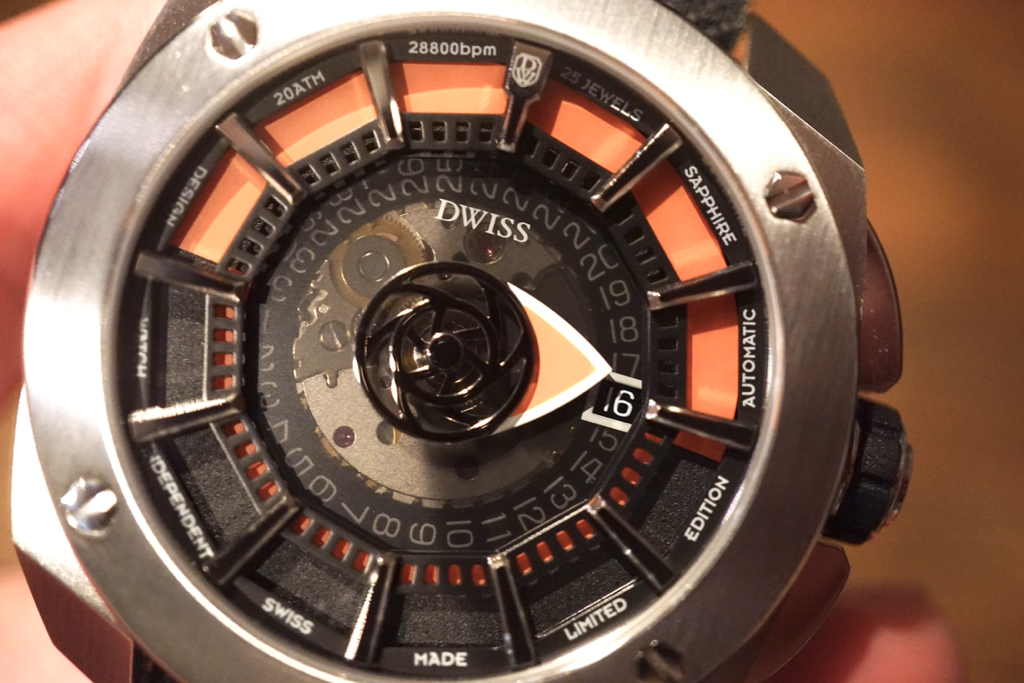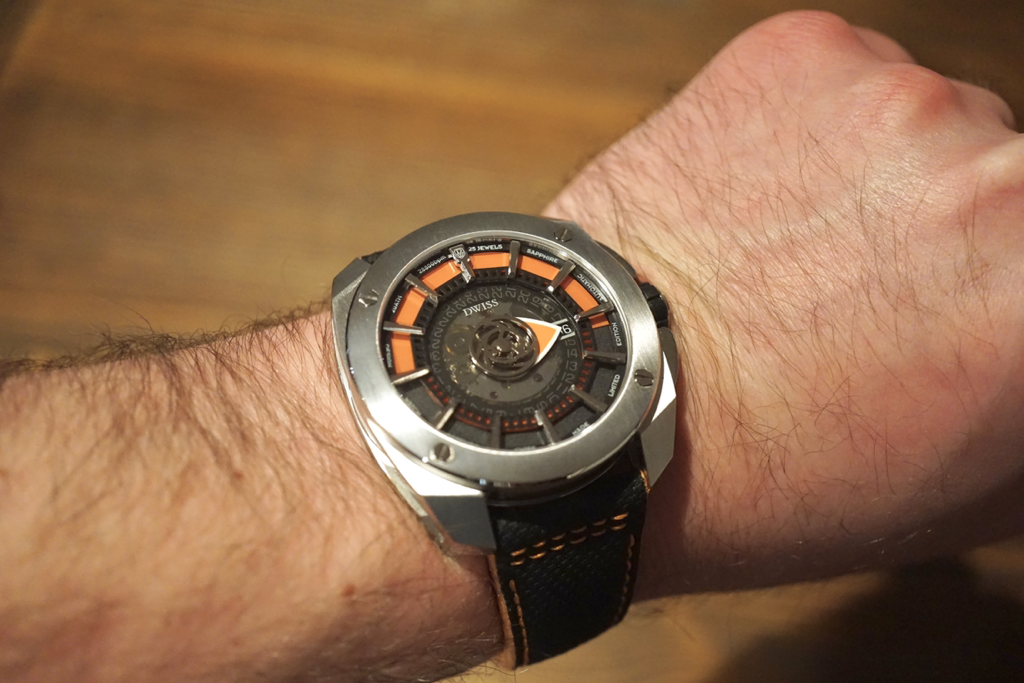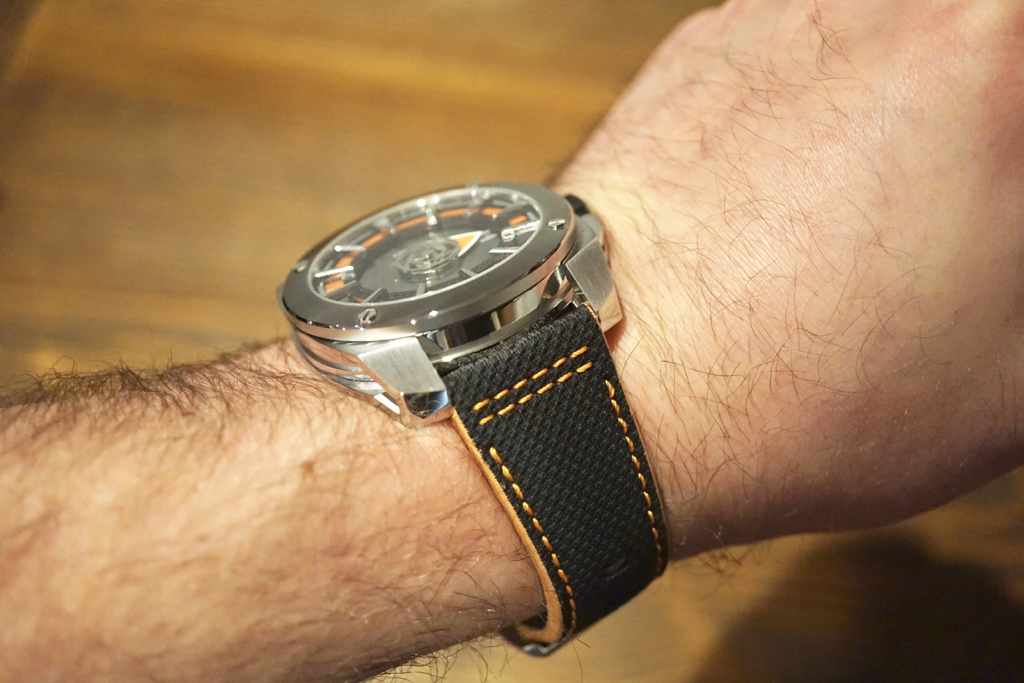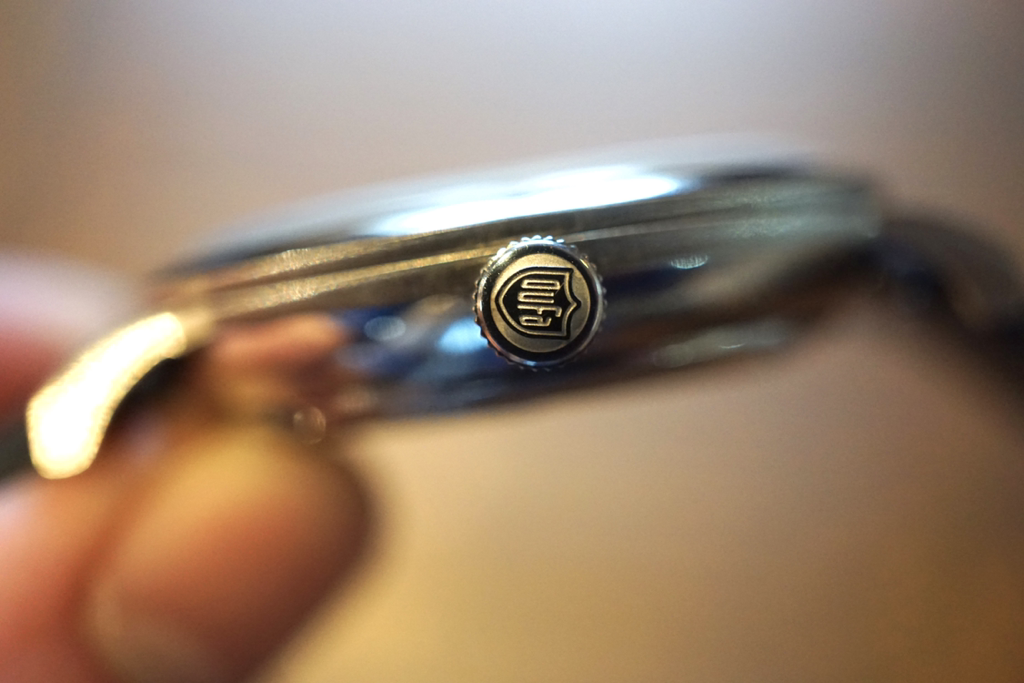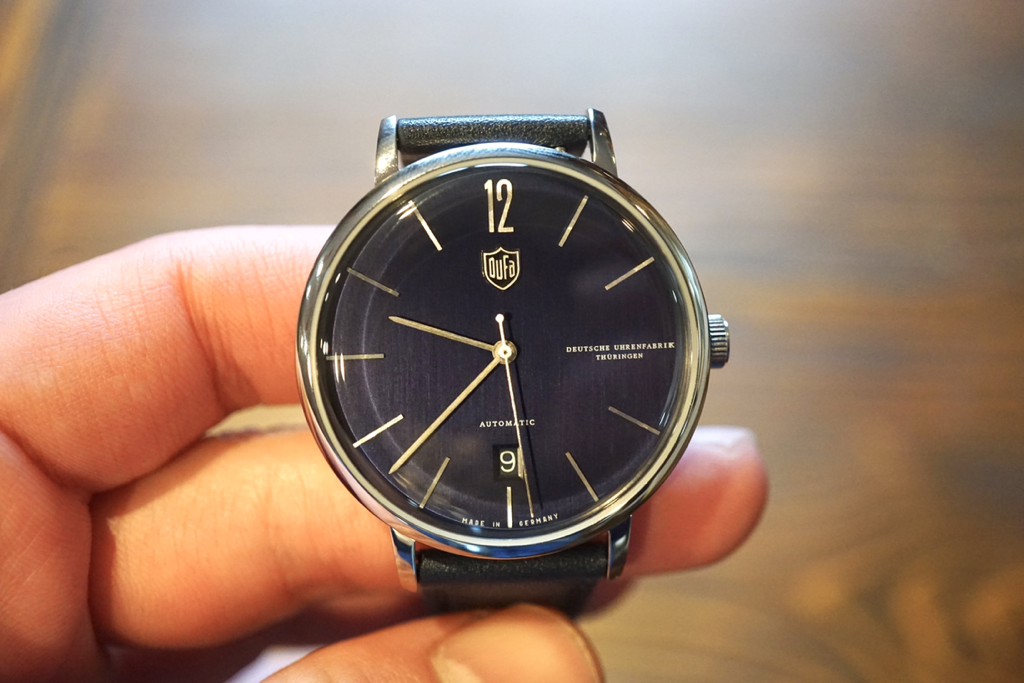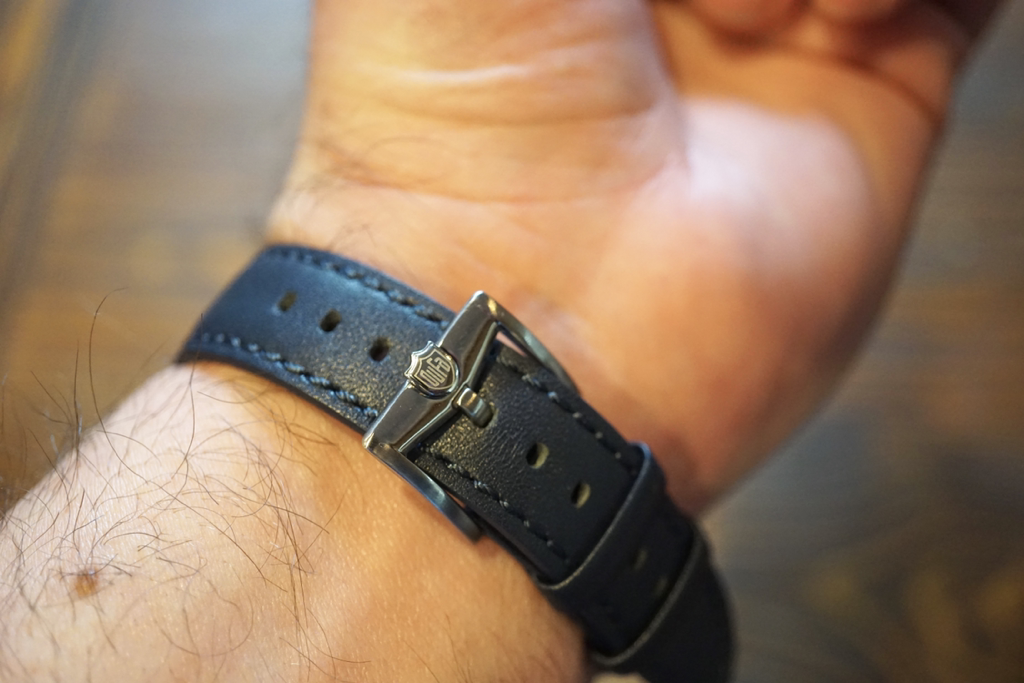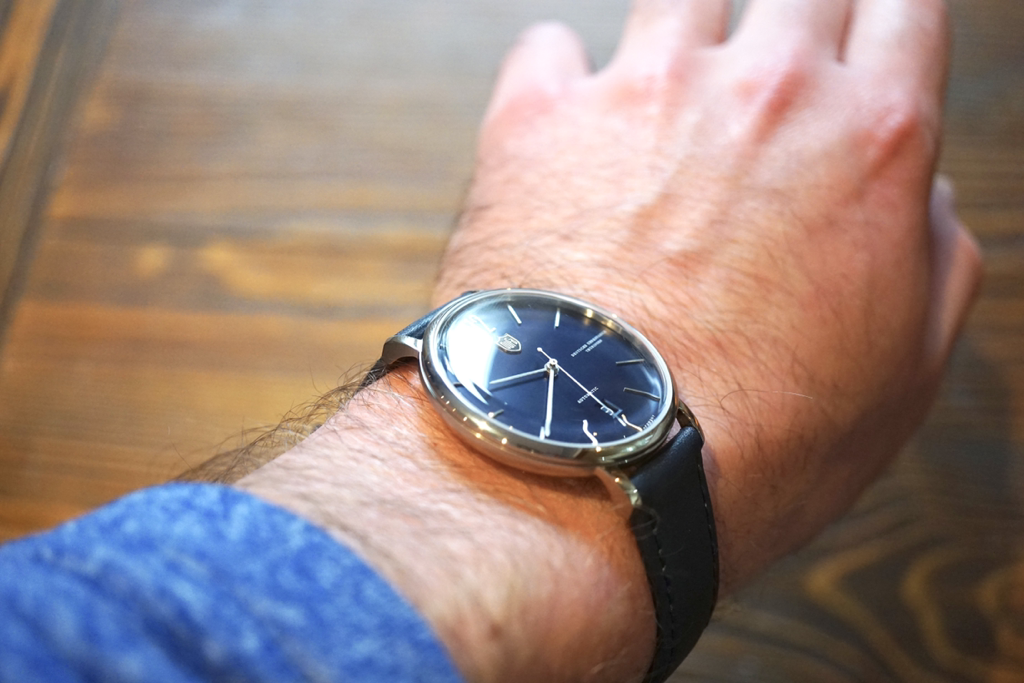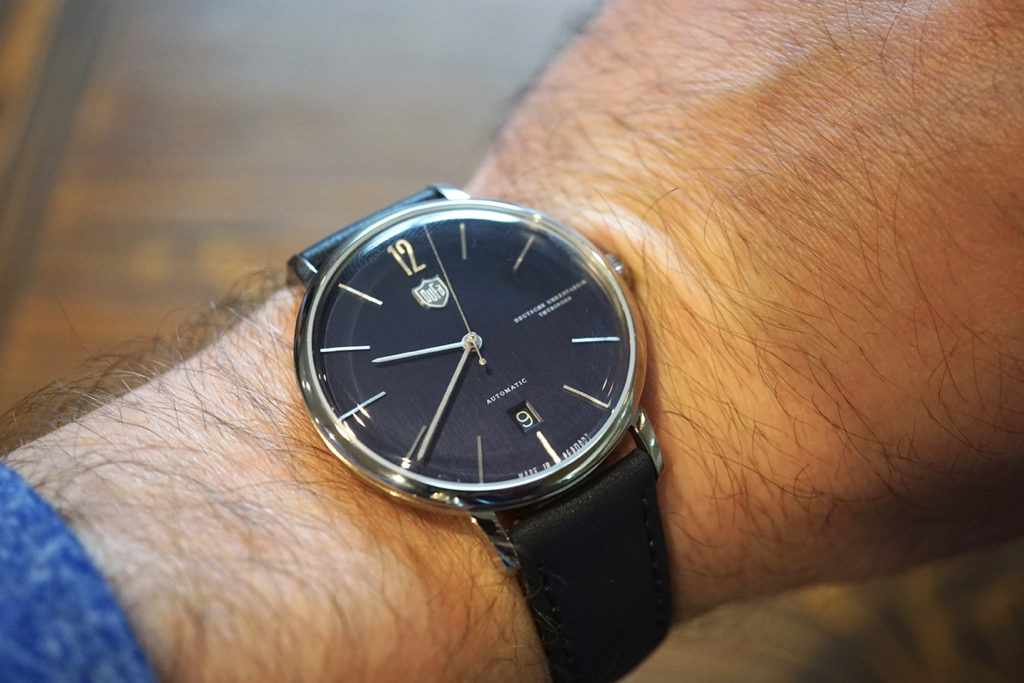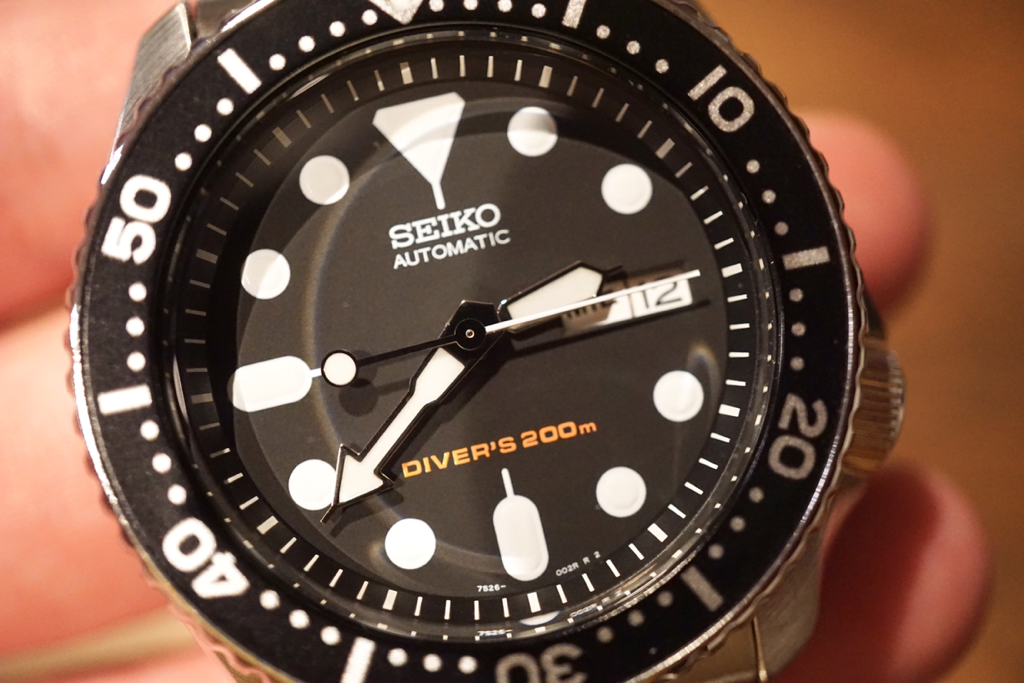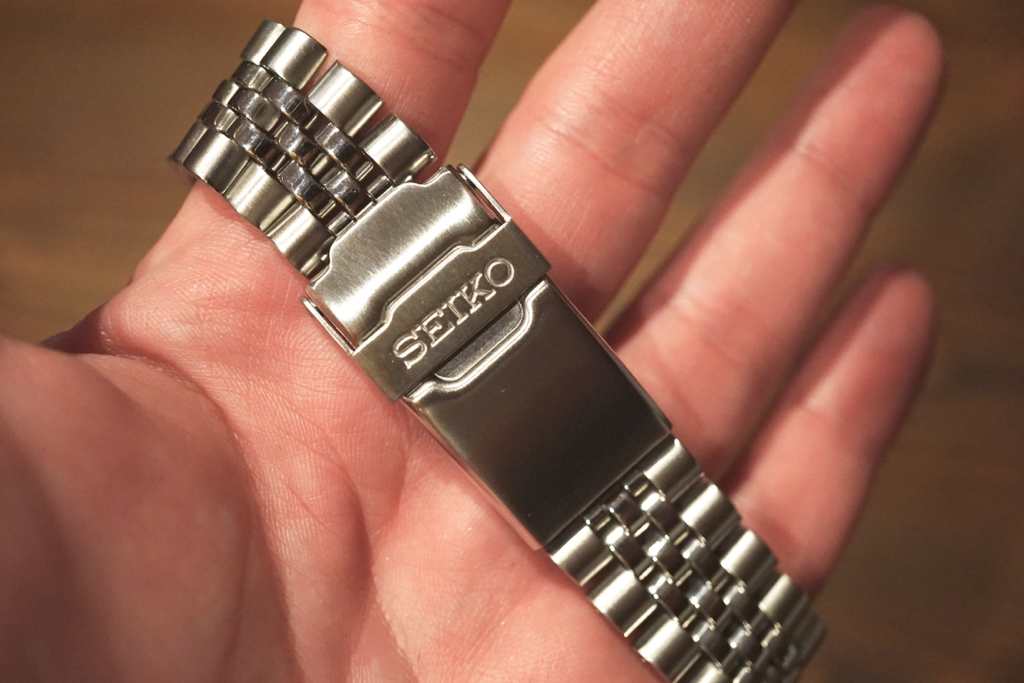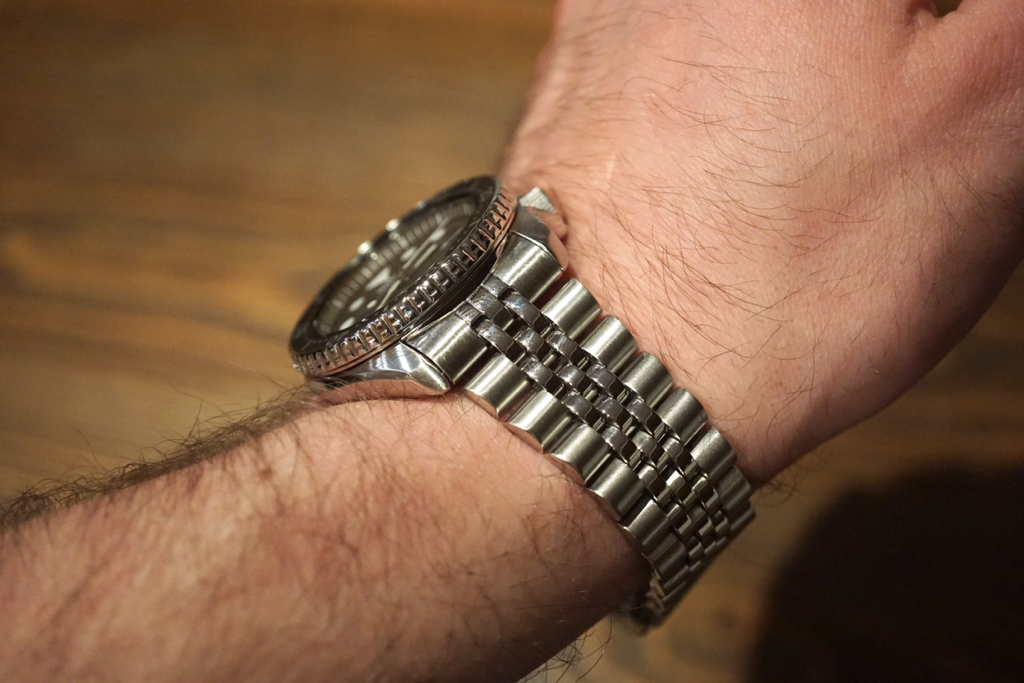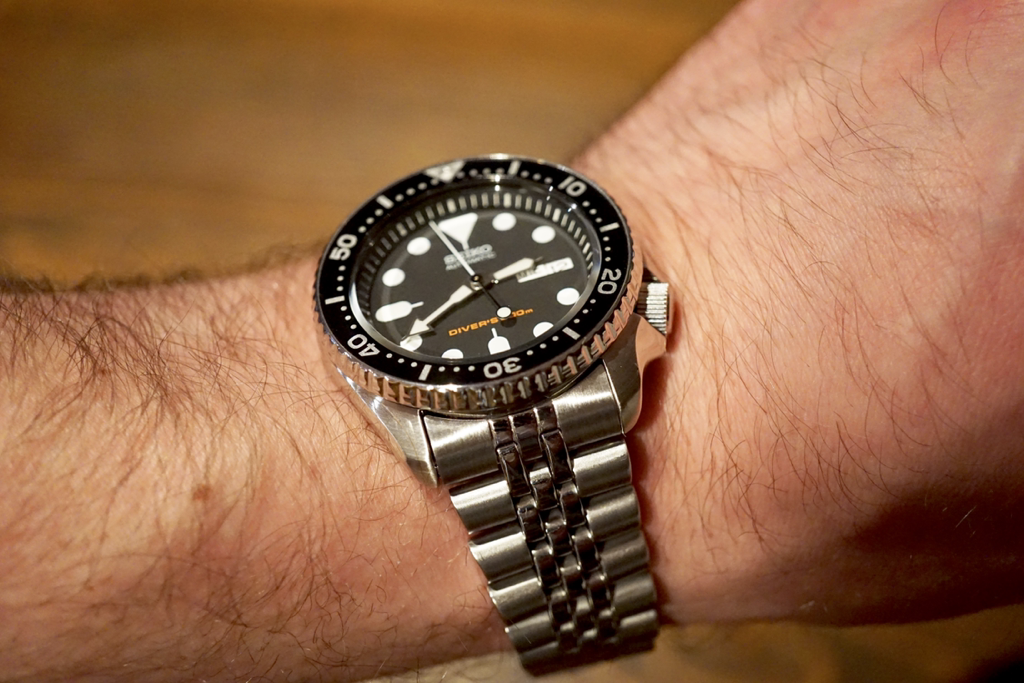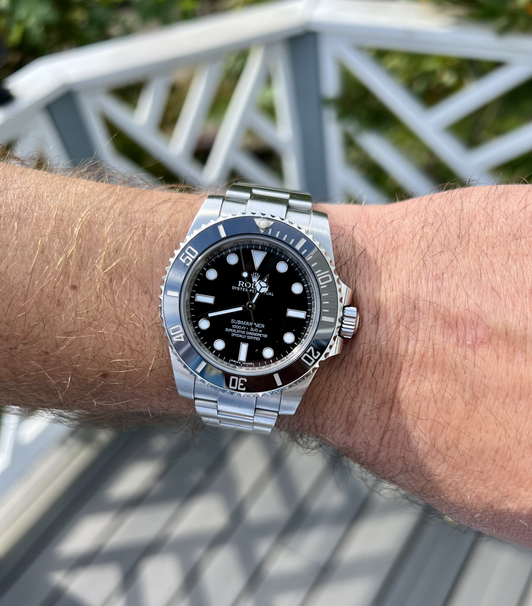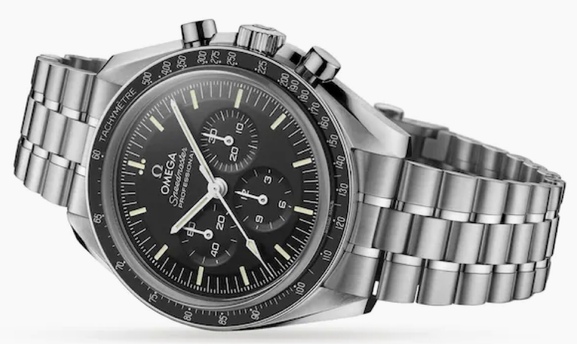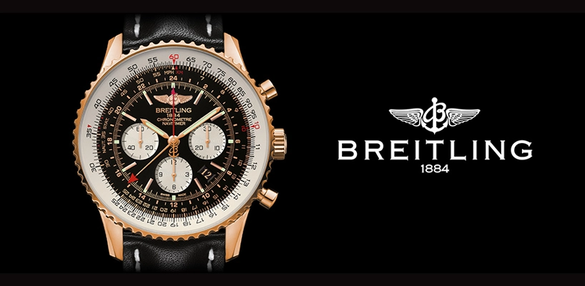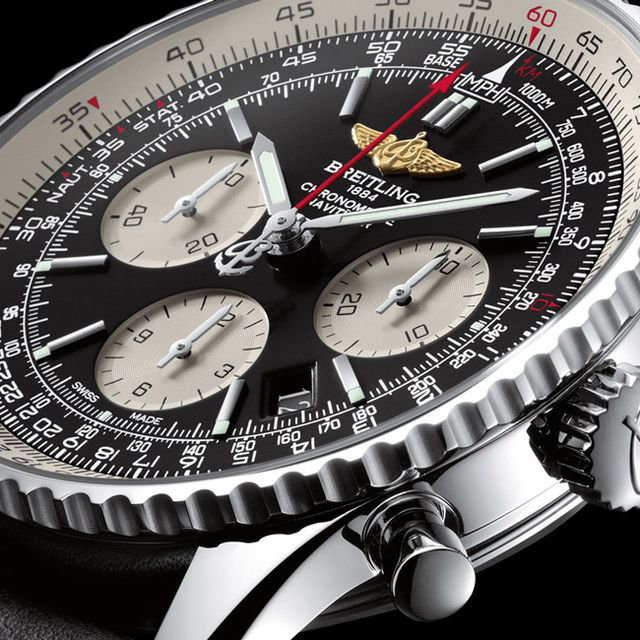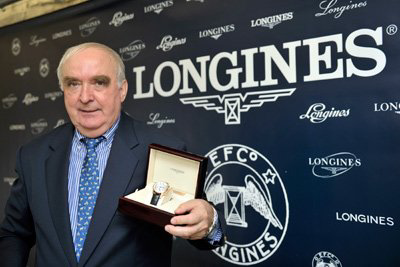CaseThe Seiko SRPC53 is housed in a really interesting curved solid 316L stainless steel case with larger dimensions of 44MM x 50mm x 13.3MM. The case almost slightly reminds me of the twisted Omega Speedmaster lugs, but not 1:1. Overall, the brushing is very neat on the sides while the lug tops contain a high polish for some nice contrast. When on wrist, it certainly pops straight out at you when reading the time due to its’ case shape. The caseback itself is screwed down whilst the crown is pull and push giving us 100 Meters of water resistance. This watch definitely is not a true dive watch but one that can be used to swim, shower, and pretty much any other water activity besides deep diving. A nice feature is the exhinition caseback which shows off the Seiko 4R36 automatic movement. DialThe matte black dial is clean, crisp, and legible at every angle. A flat hardlex crystal sitting om top of it does insure that as well. The actual layout of the hands and applied lumed markers are quite similiar to the Seiko Samurai which was released to the public over a year ago. All in all, everything is proportioned well, and seems to be in place without too much clutter. Now, the lume is not as bright as Seiko Lumibrite but I would say it is somewhat on the level of C3 SuperLuminova. MovementInside this watch resides the seiko 4R36 automatic movement. We do get a nice day and date feature at the 3:00 position which is quite legible and even contains a black wheel to match the dial color. Essentially, this is an NH35 with a day functiom. Some positives include hand winding. hacking, and a 40 hour power reserve along with 24 jewels. It is also fairly accurate, losing around four seconds a day on my iteration. BraceletThe bracelet is a typical Seiko 5 oyster style bracelet. They are not the highest quality with rather flat links and zero curvature, but there are some positives. The actual bracelet is comfortable and easily adjustable with pins and does feature a decent ammount of micro adjustments to insure a perfect fit. Also, there is no dive extension which is a positive for me because those things always hurt my wrist for some reason and allow the bracelet to sit high and awkward clasp side. Other than that, it is definitely useable and functional. ConclusionFurthermore, the SRPC53 certainly contains DNA from the Seiko Samurai and Seiko Monster models which are priced a bit higher. If you are in the market for one of those, or just cannot stand to pay such a high price to obtain one - the SRPC53 is definitely a contendor and will satisfy your needs in my opinion.
1 Comment
You can save 20% on ANY Spinnaker watch with discount code ERIKHANDLER20 at checkout ( Includes free International Shipping )Case and DialThe all new revamped Spinnaker Cahill looks a bit different this time around, and I think they made some much needed improvements. This 200M dive watch sits in a 43MM wide case comprised of solid 316L steel coated with black IP plating. It still remains chunky at 15MM tall including the slightly domed sapphire crystal. The overall finishing looks very neat on my example with no blemishes or rough edges. If we take a look at the caseback there is indeed an exhibition window to exhibit the automatic movement that powers this watch, which is always fun to look at. The dial itself is completely different with a more no nonsense look to it. The brushed grey markers are applied neatly, and the addition of a 24 hour military time is printed below that. I like the fact that they added lumed plots above the numerals, which are filled with green Swiss SuperLuminova for visibility in the dark. The 120 Click Lumed Unidirectional dive bezel is also improved with minimal backplay and perfect alignment which is a big thing for us watch addicts. Overall, the dial feels very militaristic with the crosshair and bold numerals, which is aesthetically pleasing to my tastes. MovementBeating at 3 HZ - the Seiko NH35 automatic caliber is used here which is typical in a dive watch at this price bracket. These are actually really accurate and they even have hand winding with a hack feature if you did not know. I am getting around +6 seconds a day which is superb. StrapThe 22MM genuine leather water resistant band is the same one used on most of their watches in different flavors. They are quite supple and easy to break in with hand stitched ends. I really have no issue with these and even have tested the water resistance myself with zero problems. The strap however does not taper at all assuming they did this to match the larger case diameter on this model compared to the smaller divers at 40MM they usually release. ConclusionFurthermore, Spinnaker models have definitely
improved since I reviewed their first model a couple years ago. The overall quality is decent for the asking price ( Especially with the discount code ). I like the fact that they don’t produce straight 1:1 homages like other brands, but incorporate characteristics of vintage divers into fresh designs. 12/14/2018 2 Comments Melbourne Watch Company Flinders Automatic Watch Review - A well built dress watch at an affordable priceHand Assembled in Melbourne, AUCaseThe Melbourne Flinders is no doubt a classic and elegant mens dress piece. It has all the characteristics of a true watch which can be dressed up, or even worn casually if you must. It also has rather pleasant dimensions at 40MM wide and an incredible slim profile of 9.8MM ( Yes , it will fit under a cuff ). I found the rose gold IP plating to be quite neat and smooth, with its brushed case sides while the lug sides remain polished for some pop. I believe the actual screw down caseback and lugs are one piece, whilst the circular case and smooth polished bezel are a separate piece. I found this to be quite interesting and unique as I honestly have never seen this type of construction. It is a relatively affordable piece at around $450 USD - but does contain all of the goodies including an AR coated sapphire crystal and exhibition sapphire back. DialThe dial is an off-white color which matches the Rose Gold well, and features two layers. If we head to the inner portion of the dial where there are white horizontal planks which resemble the deck of a fancy ship or yacht. Applied faceted indices are brushed on top and tipped off with a high polish which matches the polished smooth bezel nicely. It is rather a no nonsense dress watch with our bordered date window at 3:00 containing a white wheel to match the dial. I looked in a bit closer on a macro level at the print work below 12:00 and above 6:00 - to find no errors and neat script and standard writing. They have definitely done the rounds on these making sure perfection is implimented into each one of their timepieces. If you did not know Melbourne Watch Co actually hand assembles their models in Australia - making these basically an australian made timepiece...which is super cool. Lastly, the hands are blued for that traditional elegant look and definitely legibile with an “M” counter balance on the long sweeping seconds hand which reaches to the end of the dial ( Yes, I hate when companies use short hands - But No Worries here! ) MovementTaking a look at the caseback we can see the Swiss Made automatic Sellitta SW-200-1 movement. I do have a lot of experience with this movement and it is essentially the same as an ETA 2824-2. It also contains hand winding, hacking, and 21 jewels - while boasting a decent power reserve of 38 hours. Small details such as the custom rotor are not really expected at this pricepoint , but kudos to them for going the extra mile. If you are an accuracy freak like me, I did record the timekeeping of this model and it is gaining around 2 seconds a day, which is truly outstanding. Supplied Leather BandA brown genuine leather 20MM band which contains Quick-Release spring bars comes standard on the Flinders. Straight out of the box it does conform to the wrist and fits quite comfortably on my 6.5” wrist. The buckle itself is signed with the “M” for Melbourne and features the same high polished rose gold finish we see on the case itself. ConclusionIn conclusion, I think this is truly an undervalued watch. The watch itself is using a very good swiss automatic movement...it is actually assembled by hand in Australia...and comes in an interesting case with decent finishing. I do see a lot of microbrands of lesser quality and even lower grade movements charging upwards of $500-$600 with no real “Uniqueness”. Melbourne definitely has a winner on their hands with the flinders model and it seems it is quite successful as this is their Mark 2 version. I highly reccommend you check them out, and see what they have to offer. Let me finish this off by saying...It does not feel like a microbrand watch at all, rather from a swiss entry level luxury brand. Thanks for reading as always and stay tuned for more reviews.
Dwiss is offering a special promotion ending Dec. 16TH - Link Below
|
Archives
February 2024
|
ROLEX HISTORY
Rolex is a Swiss luxury watch brand that was founded in 1905 by Hans Wilsdorf and Alfred Davis in London, England. The company originally began as Wilsdorf and Davis, but it was later renamed to Rolex in 1908.
The first Rolex watches were not manufactured in-house, but instead were made by other watchmakers and then branded with the Rolex name. However, Wilsdorf had a vision of creating a wristwatch that was both reliable and accurate, and he set out to develop his own movements.
In 1910, Rolex became the first wristwatch to receive the Swiss Certificate of Chronometric Precision, which was a testament to the accuracy of the watch. Over the years, Rolex continued to innovate and develop new technologies and features, such as the first waterproof wristwatch in 1926, the first self-winding mechanism in 1931, and the first wristwatch with a date display in 1945.
Rolex has also been associated with several famous individuals, including explorers, athletes, and celebrities. For example, Sir Edmund Hillary and Tenzing Norgay wore Rolex watches when they became the first people to reach the summit of Mount Everest in 1953. Rolex has also been the official timekeeper of several sporting events, including Wimbledon and the Formula 1 Grand Prix.
Today, Rolex is one of the most recognized and respected luxury watch brands in the world, known for its quality, precision, and timeless style.
The first Rolex watches were not manufactured in-house, but instead were made by other watchmakers and then branded with the Rolex name. However, Wilsdorf had a vision of creating a wristwatch that was both reliable and accurate, and he set out to develop his own movements.
In 1910, Rolex became the first wristwatch to receive the Swiss Certificate of Chronometric Precision, which was a testament to the accuracy of the watch. Over the years, Rolex continued to innovate and develop new technologies and features, such as the first waterproof wristwatch in 1926, the first self-winding mechanism in 1931, and the first wristwatch with a date display in 1945.
Rolex has also been associated with several famous individuals, including explorers, athletes, and celebrities. For example, Sir Edmund Hillary and Tenzing Norgay wore Rolex watches when they became the first people to reach the summit of Mount Everest in 1953. Rolex has also been the official timekeeper of several sporting events, including Wimbledon and the Formula 1 Grand Prix.
Today, Rolex is one of the most recognized and respected luxury watch brands in the world, known for its quality, precision, and timeless style.
OMEGA Watches History
Omega is a Swiss luxury watch brand founded in 1848 by Louis Brandt in La Chaux-de-Fonds, Switzerland. The brand initially operated under the name La Generale Watch Co. and produced pocket watches.
In 1894, Omega revolutionized the watch industry with the introduction of the 19-ligne Omega Calibre, which was more accurate and reliable than any other watch movement of the time. This innovation earned Omega numerous awards and accolades, and the brand quickly became known for its precision and quality.
In 1903, Omega was chosen as the official timekeeper for the Gordon Bennett Cup, an international balloon race. This marked the beginning of Omega's long-standing relationship with sports timing and its reputation as a reliable and accurate timekeeper.
In 1932, Omega became the first brand to be awarded the Olympic Cross of Merit for its outstanding contribution to sports timing at the Olympic Games. Since then, Omega has been the official timekeeper for numerous Olympic Games, and its timekeeping technology has continued to evolve and improve.
In the 1950s and 1960s, Omega's watches were worn by famous explorers and adventurers, including Sir Edmund Hillary and Tenzing Norgay during their ascent of Mount Everest in 1953, and Jacques Cousteau during his underwater expeditions.
In the 1960s, Omega introduced the Speedmaster, a chronograph watch that was originally designed for motorsports but became famous as the first watch worn on the moon during the Apollo 11 mission in 1969. The Speedmaster has since become one of Omega's most iconic and sought-after models.
Today, Omega continues to innovate and produce high-quality watches, including the Seamaster, Constellation, and De Ville collections. The brand also continues to be the official timekeeper for numerous sporting events, including the Olympic Games and the America's Cup.
In 1894, Omega revolutionized the watch industry with the introduction of the 19-ligne Omega Calibre, which was more accurate and reliable than any other watch movement of the time. This innovation earned Omega numerous awards and accolades, and the brand quickly became known for its precision and quality.
In 1903, Omega was chosen as the official timekeeper for the Gordon Bennett Cup, an international balloon race. This marked the beginning of Omega's long-standing relationship with sports timing and its reputation as a reliable and accurate timekeeper.
In 1932, Omega became the first brand to be awarded the Olympic Cross of Merit for its outstanding contribution to sports timing at the Olympic Games. Since then, Omega has been the official timekeeper for numerous Olympic Games, and its timekeeping technology has continued to evolve and improve.
In the 1950s and 1960s, Omega's watches were worn by famous explorers and adventurers, including Sir Edmund Hillary and Tenzing Norgay during their ascent of Mount Everest in 1953, and Jacques Cousteau during his underwater expeditions.
In the 1960s, Omega introduced the Speedmaster, a chronograph watch that was originally designed for motorsports but became famous as the first watch worn on the moon during the Apollo 11 mission in 1969. The Speedmaster has since become one of Omega's most iconic and sought-after models.
Today, Omega continues to innovate and produce high-quality watches, including the Seamaster, Constellation, and De Ville collections. The brand also continues to be the official timekeeper for numerous sporting events, including the Olympic Games and the America's Cup.
BREITLING Watches History
Breitling is a Swiss luxury watch brand that was founded in 1884 by Léon Breitling in the town of Saint-Imier in the Canton of Bern, Switzerland. Initially, the company specialized in producing chronographs and other precision timepieces for scientific and industrial purposes.
In 1915, Breitling introduced the first wrist-worn chronograph with a separate pusher to control the start, stop, and reset functions, which made it easier to use than previous models. This innovation helped establish Breitling as a leading maker of chronographs and other precision timepieces.
During the 1930s and 1940s, Breitling continued to innovate with the introduction of the first chronograph with a second independent pusher, which allowed for the recording of multiple elapsed times. The company also developed the Huit Aviation Department, which produced wristwatches for pilots and other aviation professionals.
In the 1950s, Breitling introduced the Navitimer, a wristwatch with a built-in slide rule that allowed pilots to perform complex calculations in-flight. The Navitimer became an instant classic and remains one of Breitling's most popular models to this day.
In the 1960s, Breitling continued to produce innovative timepieces, including the Chrono-Matic, which was the first automatic chronograph movement with a micro-rotor. The company also introduced the Emergency, a wristwatch with a built-in distress beacon that could be activated in case of an emergency.
In the years since, Breitling has continued to produce innovative and high-quality timepieces for a variety of applications, including aviation, diving, and sports. The company has also maintained a strong commitment to precision and accuracy, with many of its watches featuring COSC-certified movements. Today, Breitling is recognized as one of the world's leading luxury watch brands, with a reputation for innovation, quality, and style.
In 1915, Breitling introduced the first wrist-worn chronograph with a separate pusher to control the start, stop, and reset functions, which made it easier to use than previous models. This innovation helped establish Breitling as a leading maker of chronographs and other precision timepieces.
During the 1930s and 1940s, Breitling continued to innovate with the introduction of the first chronograph with a second independent pusher, which allowed for the recording of multiple elapsed times. The company also developed the Huit Aviation Department, which produced wristwatches for pilots and other aviation professionals.
In the 1950s, Breitling introduced the Navitimer, a wristwatch with a built-in slide rule that allowed pilots to perform complex calculations in-flight. The Navitimer became an instant classic and remains one of Breitling's most popular models to this day.
In the 1960s, Breitling continued to produce innovative timepieces, including the Chrono-Matic, which was the first automatic chronograph movement with a micro-rotor. The company also introduced the Emergency, a wristwatch with a built-in distress beacon that could be activated in case of an emergency.
In the years since, Breitling has continued to produce innovative and high-quality timepieces for a variety of applications, including aviation, diving, and sports. The company has also maintained a strong commitment to precision and accuracy, with many of its watches featuring COSC-certified movements. Today, Breitling is recognized as one of the world's leading luxury watch brands, with a reputation for innovation, quality, and style.
Longines
Longines is a Swiss luxury watch company that was founded in 1832 by Auguste Agassiz in the town of Saint-Imier, Switzerland. The company has a long and prestigious history in the world of watchmaking, and has been responsible for many innovations and milestones in the industry.
In the early days, Longines primarily produced pocket watches, and quickly gained a reputation for precision and accuracy. By the end of the 19th century, Longines had become one of the leading watchmakers in the world. In 1912, the company introduced the first chronograph wristwatch, which was quickly adopted by the military and aviation communities.
In the 1920s and 1930s, Longines continued to innovate with the introduction of the world's first quartz clock and the first wristwatch with an automatic winding mechanism. During World War II, Longines produced wristwatches for the British Royal Air Force, and continued to produce military watches for several decades afterwards.
In the post-war years, Longines became known for its elegant and sophisticated watches, particularly its "Conquest" line of watches. In the 1950s and 1960s, Longines was a favorite of celebrities and politicians, and its watches were frequently seen on the wrists of Elvis Presley, John F. Kennedy, and other famous figures.
In recent years, Longines has continued to produce high-quality watches that combine traditional Swiss craftsmanship with modern technology. The company is particularly known for its sport watches, including its "HydroConquest" line of diving watches and its "Conquest Classic" line of chronographs.
Today, Longines is owned by the Swatch Group, and remains a leading brand in the luxury watch industry. Its watches are prized for their precision, reliability, and timeless style.
In the early days, Longines primarily produced pocket watches, and quickly gained a reputation for precision and accuracy. By the end of the 19th century, Longines had become one of the leading watchmakers in the world. In 1912, the company introduced the first chronograph wristwatch, which was quickly adopted by the military and aviation communities.
In the 1920s and 1930s, Longines continued to innovate with the introduction of the world's first quartz clock and the first wristwatch with an automatic winding mechanism. During World War II, Longines produced wristwatches for the British Royal Air Force, and continued to produce military watches for several decades afterwards.
In the post-war years, Longines became known for its elegant and sophisticated watches, particularly its "Conquest" line of watches. In the 1950s and 1960s, Longines was a favorite of celebrities and politicians, and its watches were frequently seen on the wrists of Elvis Presley, John F. Kennedy, and other famous figures.
In recent years, Longines has continued to produce high-quality watches that combine traditional Swiss craftsmanship with modern technology. The company is particularly known for its sport watches, including its "HydroConquest" line of diving watches and its "Conquest Classic" line of chronographs.
Today, Longines is owned by the Swatch Group, and remains a leading brand in the luxury watch industry. Its watches are prized for their precision, reliability, and timeless style.
Tissot
Tissot is a Swiss watch brand that was founded in 1853 by Charles-Félicien Tissot and his son Charles-Émile Tissot in the town of Le Locle, Switzerland. The company has a long and rich history in the world of watchmaking, and has been responsible for many innovations and milestones in the industry.
In the early days, Tissot primarily produced pocket watches, and quickly gained a reputation for quality and precision. By the end of the 19th century, Tissot was one of the largest watchmakers in Switzerland, and was exporting its watches to countries around the world.
In the early 20th century, Tissot continued to innovate with the introduction of the first non-magnetic wristwatch, the first dual time-zone watch, and the first watch with a plastic case. During World War II, Tissot produced watches for the Allied forces, and continued to produce military watches for several decades afterwards.
In the post-war years, Tissot became known for its elegant and sophisticated watches, particularly its "Tissot Visodate" line of watches, which featured a date function and a distinctive "T" logo on the dial. In the 1970s, Tissot was one of the first Swiss watch brands to introduce quartz watches, which quickly became popular due to their accuracy and affordability.
In recent years, Tissot has continued to produce high-quality watches that combine traditional Swiss craftsmanship with modern technology. The company is particularly known for its sport watches, including its "T-Touch" line of watches, which feature touch-screen technology and a range of functions such as altimeter, compass, and thermometer.
Today, Tissot is part of the Swatch Group, and remains a leading brand in the watch industry. Its watches are prized for their quality, durability, and stylish design, and are worn by watch enthusiasts and collectors around the world.
In the early days, Tissot primarily produced pocket watches, and quickly gained a reputation for quality and precision. By the end of the 19th century, Tissot was one of the largest watchmakers in Switzerland, and was exporting its watches to countries around the world.
In the early 20th century, Tissot continued to innovate with the introduction of the first non-magnetic wristwatch, the first dual time-zone watch, and the first watch with a plastic case. During World War II, Tissot produced watches for the Allied forces, and continued to produce military watches for several decades afterwards.
In the post-war years, Tissot became known for its elegant and sophisticated watches, particularly its "Tissot Visodate" line of watches, which featured a date function and a distinctive "T" logo on the dial. In the 1970s, Tissot was one of the first Swiss watch brands to introduce quartz watches, which quickly became popular due to their accuracy and affordability.
In recent years, Tissot has continued to produce high-quality watches that combine traditional Swiss craftsmanship with modern technology. The company is particularly known for its sport watches, including its "T-Touch" line of watches, which feature touch-screen technology and a range of functions such as altimeter, compass, and thermometer.
Today, Tissot is part of the Swatch Group, and remains a leading brand in the watch industry. Its watches are prized for their quality, durability, and stylish design, and are worn by watch enthusiasts and collectors around the world.


















